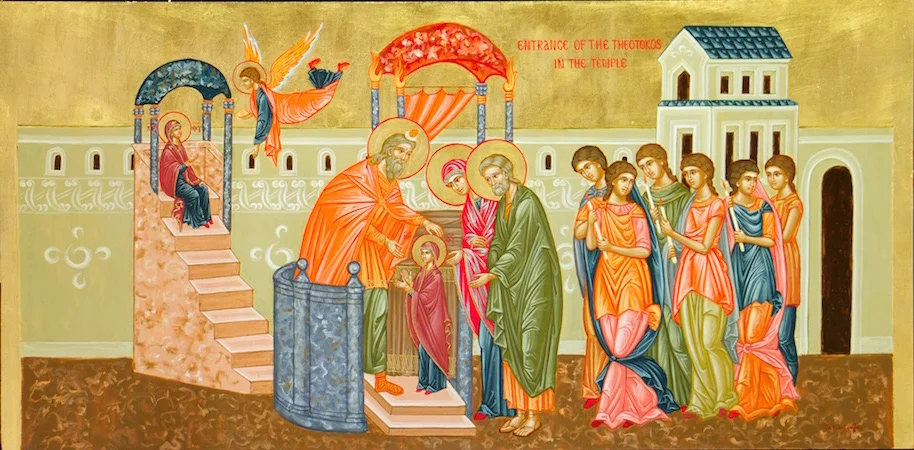by Fr Gabriel-Allan Boyd
“For you are the temple of the living God.” 2 Corinthians 6:16
What’s the meaning of this week’s major feast of the Entrance of the Theotokos in the Temple? Why is it such a big deal? Why should you care? What does it signify in your life? …in your kids’ lives? …in the life of our parish?
This feast is a wonderful blending between the most awe-inspiring parts of the Old Testament and the New Testament. In the Old Testament, only the High Priest could enter the innermost room of the Temple, the Holy of Holies (where the presence of God dwelt) …and that High Priest could only do that once a year. But in our feast day, we celebrate the day that the little three-year-old Theotokos—she who is the Living Temple—was brought by her parents (Joachim & Anna) into the Jewish Temple, proceeding up the stairs to the inside of the Holy of Holies, where she would live for the next nine years. There, the angels would keep her nourished with heavenly sustenance.
According to Saint Gregory Palamas, she grew up, listening to the writings of Moses (from Genesis through Deuteronomy) and also the revelations of the other prophets, when, every Saturday, all the people gathered at the Temple to hear it read and taught. She learned about Adam and Eve and everything that happened to them: how they were brought into being from the dust of the earth, settled in paradise and given a fasting commandment there, not to eat from the Tree of Knowledge of Good & Evil; about the evil-one’s destructive advise and the consequential theft of life from them; resulting in their expulsion from paradise and their corruption-unto-death…which altered their way of life to an experience full of pain. In addition, she saw that, as time passed, life continued under the curse of death we all inherited from them and grew even worse. God’s creation of humanity, who were made in His image, had become estranged from their Creator, and had unwittingly become more and more closely aligned with the one who had diabolically schemed for their ultimate destruction. She became acutely aware of the evil one’s power over humanity and his limitless rage against us! She became clearly attentive to humanity’s insensitivity and to our miserable inclination to return to the earth! From the history of God’s relationship with His people, Israel, she could clearly see that no one was capable of putting an end to this impulse which brings devastation on all of humanity alike. She clearly saw humanity’s unescapable rush towards its own everlasting torment. When the holy Virgin Maid heard and understood this, she was filled with compassion for all of humanity and, with the aim of finding a remedy to counteract this terrible condition, she resolved at once to turn with her whole mind to God. She took it upon herself to represent us to Him, pleading so that she might compel Him Who is above compulsion—quickly drawing Him towards us, so that He might remove the curse from among us, halt the escalating fire burning men’s souls, weaken our enemies, answer our prayers, shine upon us with His Light that never sets and, having healed our sickness, unite His creation with Himself.
Imagine how inconvenient it must have felt for the priests and Temple-caretakers to have an enthusiastic, little three-year-old girl constantly in the mix. Yet, as little Mary grew up in the Jewish Temple, being filled with its atmosphere—it had a transfiguring effect on her own humanity. Being nourished with heavenly food gave her insight into God’s mysteries being revealed. Being immersed in the scriptures—in the story of humanity’s tragic failure to become what God had intended—and in the story of God’s desire to have humanity united with Him—gave her an immense sense of compassion. Being continually in the place of God’s fiery presence filled her with immeasurable love. Her intimate nine-year relationship with the life of the Temple was preparing her for what would be her role in the story of salvation.
More Spacious Than The Heavens
And this is the main theme of the Feast of Mary’s Entrance Into the Temple. In fact, this theme is repeated many times throughout the liturgical services of the feast—that she enters the Temple to learn what it means for her to become the living temple of God—holding within her womb the God who created the heavens and the earth, thereby becoming “more spacious than the heavens.” This introduces God’s New Testament message whereby the prophecies from the Old Testament are fulfilled—the Good News that “the dwelling of God is with humanity.” And since Mary, the Theotokos is the prototype for every Christian (the first among equals, of all the saints), she reveals that the human person is the intended dwelling place for God’s Presence.
“My dwelling place will be with them; I will be their God, and they will be My people” (Ezekiel 37:27); “If you love Me, keep my commands. And I will ask the Father, and he will give you another Advocate to help you and be with you forever—the Spirit of truth. The world cannot accept Him, because it neither sees Him nor knows Him. But you know Him, for He lives with you and will be in you. I will not leave you as orphans; I will come to you. Before long, the world will not see Me anymore, but you will see Me. Because I live, you also will live. On that day you will realize that I am in My Father, and you are in Me, and I am in you. Whoever has My commands and keeps them is the one who loves Me. The one who loves Me will be loved by My Father, and I too will love them and show Myself to them.” Then Judas (not Judas Iscariot) said, “But, Lord, why do you intend to show Yourself to us and not to the world?” Jesus replied, “Anyone who loves Me will obey my teaching. My Father will love them, and We will come to them and make Our home with them” (John 14:15–23); “Or, do you not know that your body is the temple of the Holy Spirit who is in you, whom you have from God, and you are not your own?” (1 Corinthians 6:19); “For through Him [Christ] we both have access to the Father by one Spirit. Consequently, you are no longer foreigners and strangers, but fellow citizens with God’s people and also members of his household, built on the foundation of the apostles and prophets, with Christ Jesus Himself as the chief cornerstone. In Him the whole building is joined together and rises to become a holy temple in the Lord. And in Him you too are being built together to become a dwelling in which God lives by his Spirit” (Ephesians 2:18–22).
The Feast of the Entrance of the Theotokos Into The Temple calls us to soberly embrace a truly miraculous, God-given role—that, like the Theotokos, each of us is being prepared by all the tools the Church gives us (reading of the scriptures & the Church’s spiritual literature, prayer, almsgiving, the sacraments of confession/repentance & the Eucharist, fasting from the passions), that we may also become the temple of the Living God. Here, near the beginning of the Nativity Fast, like the little Theotokos in the Temple, we’re being reminded just how important it is for us to be on time and actively present for all the divine services. We’re being reminded just how important it is for us to also have our children actively present in those divine services and in this gradual work of preparation, because, just as it was with the Theotokos, a miracle of awesome proportions is also being formed in them. We’re being reminded that God wants each of us to enter into the serious business of also being more spacious than the heavens. Because, come Christmas, God also wants each of us to bear forth His Son into the world.



